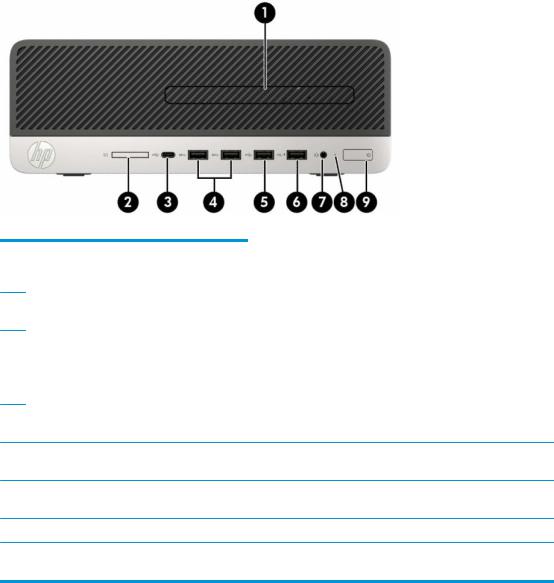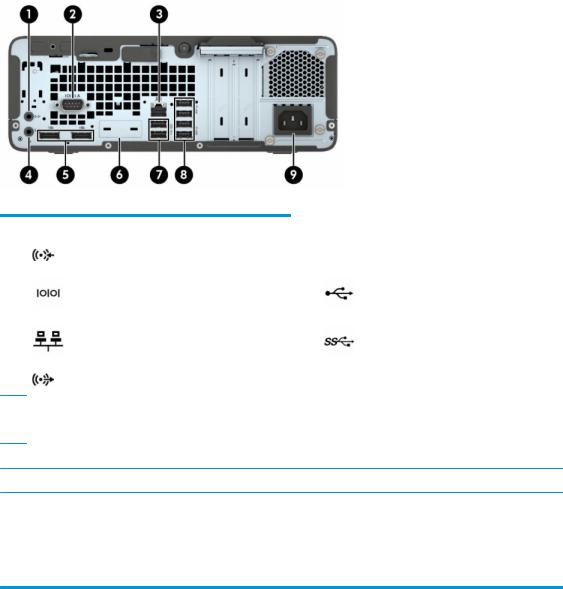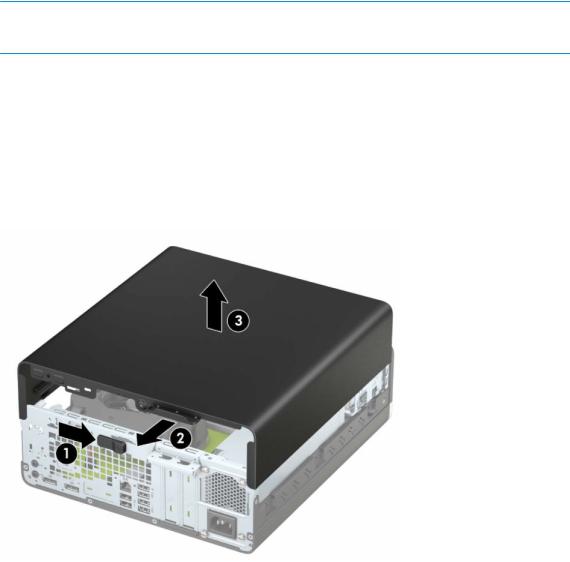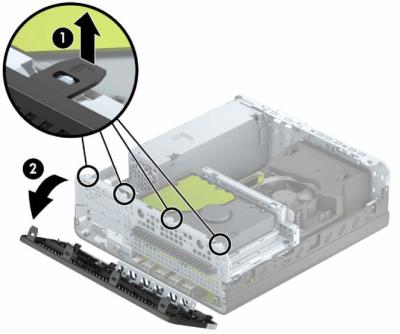HP ProDesk 600 G5 SFF User Manual

Hardware Reference Guide
© Copyright 2018, 2019 HP Development
Company, L.P.
Windows is either a registered trademark or trademark of Microsoft Corporation in the United States and/or other countries.
The information contained herein is subject to change without notice. The only warranties for HP products and services are set forth in the express warranty statements accompanying such products and services. Nothing herein should be construed as constituting an additional warranty. HP shall not be liable for technical or editorial errors or omissions contained herein.
Third Edition: June 2019
First Edition: May 2018
Document Part Number: L16888-003
Product notice
This guide describes features that are common to most models. Some features may not be available on your computer.
Not all features are available in all editions or versions of Windows. Systems may require upgraded and/or separately purchased hardware, drivers, software or BIOS update to take full advantage of Windows functionality. Windows 10 is automatically updated, which is always enabled. ISP fees may apply and additional requirements may apply over time for updates. See http://www.microsoft.com.
To access the latest user guides or manuals for your product, go to http://www.hp.com/ support and follow the instructions to find your product. Then select User Guides.
Software terms
By installing, copying, downloading, or otherwise using any software product preinstalled on this computer, you agree to be bound by the terms of the HP End User License Agreement (EULA). If you do not accept these license terms, your sole remedy is to return the entire unused product (hardware and software) within 14 days for a full refund subject to the refund policy of your seller.
For any further information or to request a full refund of the price of the computer, please contact your seller.

About This Book
This guide provides basic information for upgrading the HP ProDesk Business PC.
 WARNING! Indicates a hazardous situation that, if not avoided, could result in serious injury or death.
WARNING! Indicates a hazardous situation that, if not avoided, could result in serious injury or death.
 CAUTION: Indicates a hazardous situation that, if not avoided, could result in minor or moderate injury.
CAUTION: Indicates a hazardous situation that, if not avoided, could result in minor or moderate injury.


 IMPORTANT: Indicates information considered important but not hazard-related (for example, messages related to property damage). Warns the user that failure to follow a procedure exactly as described could result in loss of data or in damage to hardware or software. Also contains essential information to explain a concept or to complete a task.
IMPORTANT: Indicates information considered important but not hazard-related (for example, messages related to property damage). Warns the user that failure to follow a procedure exactly as described could result in loss of data or in damage to hardware or software. Also contains essential information to explain a concept or to complete a task.
 NOTE: Contains additional information to emphasize or supplement important points of the main text.
NOTE: Contains additional information to emphasize or supplement important points of the main text. 

 TIP: Provides helpful hints for completing a task.
TIP: Provides helpful hints for completing a task.
iii
iv About This Book

Table of contents
1 Product features ........................................................................................................................................... |
1 |
Standard configuration features ........................................................................................................................... |
1 |
Front panel components ....................................................................................................................................... |
2 |
Rear panel components ......................................................................................................................................... |
3 |
Serial number location .......................................................................................................................................... |
4 |
2 Hardware upgrades ....................................................................................................................................... |
5 |
Serviceability features ........................................................................................................................................... |
5 |
Warnings and cautions .......................................................................................................................................... |
5 |
Preparing for disassembly ..................................................................................................................................... |
6 |
Removing the computer access panel ................................................................................................................... |
6 |
Replacing the computer access panel ................................................................................................................... |
7 |
Removing the front bezel ...................................................................................................................................... |
8 |
Removing a slim optical drive bezel blank ............................................................................................................ |
9 |
Replacing the front bezel .................................................................................................................................... |
10 |
Removing and installing the optional front bezel dust filter .............................................................................. |
11 |
Changing from desktop to tower orientation ..................................................................................................... |
13 |
System board connections .................................................................................................................................. |
14 |
Upgrading system memory ................................................................................................................................. |
15 |
Installing a memory module ............................................................................................................. |
15 |
Removing or installing an expansion card .......................................................................................................... |
18 |
Drive positions ..................................................................................................................................................... |
22 |
Removing and installing drives ........................................................................................................................... |
23 |
Removing a 9.5 mm slim optical drive .............................................................................................. |
24 |
Installing a 9.5 mm slim optical drive ............................................................................................... |
25 |
Removing and replacing a 3.5-inch hard drive ................................................................................. |
27 |
Removing and installing an M.2 SSD storage card ........................................................................... |
31 |
Installing a security lock ...................................................................................................................................... |
34 |
Cable lock ........................................................................................................................................... |
34 |
Padlock .............................................................................................................................................. |
35 |
HP Business PC Security Lock V2 ...................................................................................................... |
36 |
Appendix A Battery replacement ..................................................................................................................... |
41 |
Appendix B Electrostatic discharge .................................................................................................................. |
45 |
Preventing electrostatic damage ........................................................................................................................ |
45 |
v
Grounding methods ............................................................................................................................................. |
45 |
Appendix C Computer operating guidelines, routine care and shipping preparation ............................................. |
46 |
Computer operating guidelines and routine care ............................................................................................... |
46 |
Optical drive precautions ..................................................................................................................................... |
47 |
Operation ........................................................................................................................................... |
47 |
Cleaning ............................................................................................................................................. |
47 |
Safety ................................................................................................................................................ |
47 |
Shipping preparation ........................................................................................................................................... |
47 |
Appendix D Accessibility ................................................................................................................................. |
48 |
Accessibility ......................................................................................................................................................... |
48 |
Finding the technology tools you need ............................................................................................ |
48 |
Our commitment ............................................................................................................................... |
48 |
International Association of Accessibility Professionals (IAAP) ....................................................... |
48 |
Finding the best assistive technology .............................................................................................. |
49 |
Assessing your needs ..................................................................................................... |
49 |
Accessibility for HP products .......................................................................................... |
49 |
Standards and legislation .................................................................................................................................... |
50 |
Standards .......................................................................................................................................... |
50 |
Mandate 376 – EN 301 549 ............................................................................................ |
50 |
Web Content Accessibility Guidelines (WCAG) ................................................................ |
50 |
Legislation and regulations .............................................................................................................. |
50 |
United States ................................................................................................................... |
51 |
21st Century Communications and Video Accessibility Act (CVAA) ............................... |
51 |
Canada ............................................................................................................................. |
51 |
Europe ............................................................................................................................. |
52 |
United Kingdom .............................................................................................................. |
52 |
Australia .......................................................................................................................... |
52 |
Worldwide ....................................................................................................................... |
52 |
Useful accessibility resources and links .............................................................................................................. |
53 |
Organizations .................................................................................................................................... |
53 |
Educational institutions .................................................................................................................... |
53 |
Other disability resources ................................................................................................................. |
53 |
HP links .............................................................................................................................................. |
53 |
Contacting support .............................................................................................................................................. |
54 |
Index ............................................................................................................................................................. |
55 |
vi

1Product features
Standard configuration features
Features may vary depending on the model. For support assistance and to learn more about the hardware and software installed on your computer model, run the HP Support Assistant utility.
 NOTE: This computer model can be used in a tower orientation or a desktop orientation.
NOTE: This computer model can be used in a tower orientation or a desktop orientation.
Standard configuration features |
1 |

Front panel components
Drive configuration may vary by model. Some models have a bezel blank covering the slim optical drive bay.
Table 1-1 Front panel components
Components |
Components |
||
|
|
|
|
1 |
Slim optical drive (select products only) |
6 |
USB port with HP Sleep and Charge*** |
2Memory card reader (select products only)
7Audio-out (headphone)/Audio-in (microphone) combo jack****
3 |
USB Type-C port with HP Sleep and Charge* |
8 |
Hard drive activity light |
|
|
|
|
4 |
USB SuperSpeed ports (2)** |
9 |
Power button |
|
|
|
|
5 |
USB port |
|
|
* Connects a USB device that has a Type-C connector, provides data transfer, and even when the computer is off, charges most products such as a cell phone, camera, activity tracker, or smartwatch.
**Connect a USB device, such as a cell phone, camera, activity tracker, or smartwatch, and provides high-speed data transfer.
***Connects a USB device, provides data transfer, and even when the computer is off, charges most products such as a cell phone, camera, activity tracker, or smartwatch.
****When a device is plugged into the jack, a dialog box is displayed. Select the type of device that is connected.
NOTE: The light on the power button is normally white when the power is on. If it is flashing red, there is a problem with the computer and it is displaying a diagnostic code. See the Maintenance and Service Guide to interpret the code.
2Chapter 1 Product features

Rear panel components
Table 1-2 Rear panel components
Components |
|
Components |
|
|
|
|
|
1 |
Audio-in jack |
6 |
Optional port |
|
|
|
|
2 |
Serial port (select products only) |
7 |
USB ports (2) |
|
|
|
|
3 |
RJ-45 (network) jack |
8 |
USB SuperSpeed ports (4)** |
|
|
|
|
4 |
Audio-out jack for powered audio devices* |
9 |
Power cord connector |
5 Dual-Mode DisplayPort monitor connectors (2)
Dual-Mode DisplayPort monitor connectors (2)
* When a device is plugged into the jack, a dialog box is displayed. Select the type of device that is connected.
** Connect a USB device, such as a cell phone, camera, activity tracker, or smartwatch, and provides high-speed data transfer.
NOTE: Your model may have additional optional ports available from HP.
When a graphics card is installed in one of the system board slots, the video connectors on the graphics card and/or the integrated graphics on the system board may be used. The specific graphics card installed and software configuration will determine the behavior.
The system board graphics can be disabled by changing settings in Computer Setup.
Rear panel components |
3 |

Serial number location
Each computer has a unique serial number and a product ID number that are located on the exterior of the computer. Keep these numbers available for use when contacting customer service for assistance.
4Chapter 1 Product features

2Hardware upgrades
Serviceability features
The computer includes features that make it easy to upgrade and service. A Torx T15 or flat-bladed screwdriver is needed for some of the installation procedures described in this chapter.
Warnings and cautions
Before performing upgrades be sure to carefully read all of the applicable instructions, cautions, and warnings in this guide.
 WARNING! To reduce the risk of personal injury from electrical shock, hot surfaces, or fire:
WARNING! To reduce the risk of personal injury from electrical shock, hot surfaces, or fire:
Disconnect the power cord from the AC outlet and allow the internal system components to cool before you touch them.
Do not plug telecommunications or telephone connectors into the network interface controller (NIC) receptacles.
Do not disable the power cord grounding plug. The grounding plug is an important safety feature. Plug the power cord into a grounded (earthed) outlet that is easily accessible at all times.
To reduce the risk of serious injury, read the Safety & Comfort Guide. It describes proper workstation setup, and proper posture, health, and work habits for computer users. The Safety & Comfort Guide also provides important electrical and mechanical safety information. The Safety & Comfort Guide is available on the Web at http://www.hp.com/ergo.
 WARNING! Energized and moving parts inside.
WARNING! Energized and moving parts inside.
Disconnect power to the equipment before removing the enclosure. Replace and secure the enclosure before re-energizing the equipment.


 IMPORTANT: Static electricity can damage the electrical components of the computer or optional equipment. Before beginning these procedures, ensure that you are discharged of static electricity by briefly touching a grounded metal object. See Electrostatic discharge on page 45 for more information.
IMPORTANT: Static electricity can damage the electrical components of the computer or optional equipment. Before beginning these procedures, ensure that you are discharged of static electricity by briefly touching a grounded metal object. See Electrostatic discharge on page 45 for more information.
When the computer is plugged into an AC power source, voltage is always applied to the system board. To prevent damage to internal components, you must disconnect the power cord from the power source before opening the computer.
Serviceability features |
5 |

Preparing for disassembly
1.Remove/disengage any security devices that prohibit opening the computer.
2.Remove all removable media, such as compact discs and USB flash drives, from the computer.
3.Turn off the computer properly through the operating system, and turn off any external devices.
4.Disconnect the power cord from the AC outlet and disconnect any external devices.
 IMPORTANT: Regardless of the power-on state, voltage is always present on the system board as long as the system is plugged into an active AC outlet. To prevent damage to internal components, you must disconnect the AC power cord from the power source before opening the computer.
IMPORTANT: Regardless of the power-on state, voltage is always present on the system board as long as the system is plugged into an active AC outlet. To prevent damage to internal components, you must disconnect the AC power cord from the power source before opening the computer.
Removing the computer access panel
To access internal components, you must remove the access panel.
1.Prepare for disassembly. See Preparing for disassembly on page 6.
2.If the computer is on a stand, remove the computer from the stand and lay the computer down.
3.Slide the access panel release lever to the right so that it locks into place (1). Then slide the access panel toward the rear of the computer (2) and lift it off the computer (3).
6Chapter 2 Hardware upgrades

Replacing the computer access panel
Be sure that the access panel release lever is locked into place, and then place the access panel on the computer (1) and slide the panel toward the front of the computer (2). The release lever will automatically move back to the left and secure the access panel.
Replacing the computer access panel |
7 |

Removing the front bezel
1.Prepare for disassembly. See Preparing for disassembly on page 6.
2.If the computer is on a stand, remove the computer from the stand and lay the computer down.
3.Remove the computer access panel. See Removing the computer access panel on page 6.
4.Lift up the four tabs on the top of the bezel (1), and then rotate the bezel off the chassis (2).
8Chapter 2 Hardware upgrades

Removing a slim optical drive bezel blank
On some models, a bezel blank covers the slim optical drive bay. Remove the bezel blank before installing an optical drive. To remove the bezel blank:
1.Prepare for disassembly. See Preparing for disassembly on page 6.
2.If the computer is on a stand, remove the computer from the stand and lay the computer down.
3.Remove the computer access panel. See Removing the computer access panel on page 6.
4.Remove the front bezel. See Removing the front bezel on page 8.
5.Then press inward on the tab on the left side of the blank (1), and then rotate the blank off the front bezel (2).
Removing a slim optical drive bezel blank |
9 |

Replacing the front bezel
Insert the four hooks on the bottom of the bezel into the rectangular holes on the chassis (1), and then rotate the top of the bezel onto the chassis (2) and snap it in place.
10 Chapter 2 Hardware upgrades

Removing and installing the optional front bezel dust filter
Some models are equipped with an optional front bezel dust filter. You must periodically clean the dust filter so that the dust collected on the filter does not impede air flow through the computer.
 NOTE: The optional front bezel dust filter is available from HP.
NOTE: The optional front bezel dust filter is available from HP.
To remove, clean, and replace the dust filter:
1.Prepare for disassembly. See Preparing for disassembly on page 6.
2.To remove the dust filter, use your fingers to separate the filter from the front bezel at the tab locations shown below.
3.Use a soft brush or cloth to clean dust from the filter. If heavily soiled, rinse the filter clean with water.
Removing and installing the optional front bezel dust filter 11

4.To replace the dust filter, press the filter firmly onto the front bezel at the tab locations shown below.
5.Reconnect the power cord and any external devices, and then turn on the computer.
12 Chapter 2 Hardware upgrades

Changing from desktop to tower orientation
The Small Form Factor computer can be used in a tower orientation with an optional tower stand that can be purchased from HP.
 NOTE: To stabilize the computer in a tower orientation, HP recommends the use of the optional tower stand.
NOTE: To stabilize the computer in a tower orientation, HP recommends the use of the optional tower stand.
1.Prepare for disassembly. See Preparing for disassembly on page 6.
2.Orient the computer so that its right side is facing down and place the computer in the optional stand.
3.Reconnect the power cord and any external devices, and then turn on the computer.
 NOTE: Be sure that at least 10.2 centimeters (4 inches) of space on all sides of the computer remains clear and free of obstructions.
NOTE: Be sure that at least 10.2 centimeters (4 inches) of space on all sides of the computer remains clear and free of obstructions.
4.Lock any security devices that were disengaged before the computer was moved.
Changing from desktop to tower orientation 13
